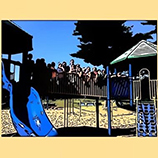
כיצד מערכת החיסון המוּלדת נלחמת עבור בריאותכם
כאשר גופנו פוגש פולשים כמו נגיפים, חיידקים, פטריות, או טפילים, פלישה זו מעוררת תהליך מורכב ומדהים שנקרא 'תגובה חיסונית'...
סוקרים צעירים



כאשר גופנו פוגש פולשים כמו נגיפים, חיידקים, פטריות, או טפילים, פלישה זו מעוררת תהליך מורכב ומדהים שנקרא 'תגובה חיסונית'...



האם אי פעם הרמתם את קולכם מאחר שמישהו לא יכול היה לשמוע אתכם? דַּמְיְנוּ שאתם מדבּרים עם חברתכם בפארק שקט. כעת...


בסרטים, הרבה דמויות מחלימות מפּציעות מהר מאוד. לחלקן, כמו לווֹלְבָּרִין או לרָפּוּנְזֶל, יש אפילו כוחות ריפוי מיוחדים...


מיקרובים נמצאים בכל מקום ויש להם חיים חברתיים, שבמסגרתם הם מְתַקְשְׁרִים עם מינים רבים. כמו כל אחד מאיתנו, מיקרובים...


אנו חיים בנקודת מפנה בהיסטוריה של כדור הארץ, ונדרשים להבין מה מתרחש. במאתיים השנים האחרונות בני האדם נהיו כל כך...






ב- 2021 צוין יום השנה ה-100 לחיסון BCG נגד שַׁחֶפֶת, ויש הרבה מה לחגוג! חיסון זה ללא ספק הציל את חייהם של מיליוני אנשים...


נגיף הפַּפִּילוֹמָה האנושי (HPV) הוא וירוס שיכול לגרום למחלות בעור וּבַמֶּמְבְּרָנוֹת ריריות בקרב נשים וגברים. ישנם...


הדיאטה האנושית היום שונה מאוד מדיאטות של פְּרִימָטִים אחרים, מה שמצביע על שינויים גדולים שהתרחשו בעקבות התפצלות שושלות...





מוח אשר נפגע עקב פגיעה מוחית טראומטית, יאבד חלק מתאיו. אם תאי המוח של אדם ניזוקים, עלולות להיווצר אצלו בעיות של שליטה...




זיכרון הוא תפקוד מוחי חיוני. חשבו על כך – מה היה קורה אם לא הייתם זוכרים דבר? לא הייתם מסוגלים להיזכר בדברים שאתם...




חיות קטנות שחיות באדמה, הנקראות חסרי חוליות באדמה, מייצגות קבוצה מגוונת מאוד של משתכני אדמה. הן כוללות תולעי אדמה...



דגי קוֹד בוגרים שוחים לאורך מאות קילומטרים הרחק מהבית במטרה לשחרר את ביציהם לתוך מֵי האוקיינוס. לאחר כמה ימים...
